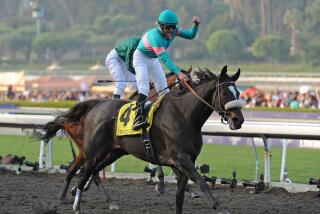HORSES : Instructor Teaches Riders to Get a Jump on Things
- Share via
When she was a little girl in England, horse lover Dorothy Baylis dreamed of jumping fences. That dream eventually took her to some of the premier show-jumping stables in England and Switzerland, where she competed in international jumping events.
Now she helps others on this side of the Atlantic fulfill the same dream. Based at Rancho Sierra Vista Stables in San Juan Capistrano, Baylis uses her international equestrian experience to teach riders to jump. Several years ago she formed DBT (Dorothy Baylis Training), which caters to equestrians--and horses--of all levels.
Unlike many professional trainers who concentrate only on advanced riders, Baylis also accepts horses and riders with no experience. Her only requirement is dedication to the sport. “I love to work with any level horse or student, as long as I can see him trying. It pleases me to see effort,” Baylis said.
Baylis knows when to push her students--human or equine--and when to give them a break. In a recent novice jumping lesson, she schooled a group of riders over a series of “gymnastics” (in which poles are set at even distances on the ground) until the horses were trotting smoothly over them.
“Don’t look down,” she coached the riders as they approached the poles. “Keep your head up. Look straight ahead for your next fence. Keep your weight evenly in the stirrups. Center your balance. Steady hand, now.”
A lot to remember at once, but through repetition, the riders eventually seem to get the hang of it. Baylis insists that repetition--and patience--are the only way to learn to jump.
“Like any sport, your body needs to adapt to the physical routine of riding. You need to develop rhythm, balance and control,” she said.
Nothing but hours and hours in the saddle will accomplish that, said Baylis, who recommends a minimum of two riding sessions per week for anyone serious about learning to ride or jump.
For those willing to put in the hours, age is no barrier. Baylis has taught beginning riders as young as 4, although most children need to be 6 or 7 to have a sufficient attention span. Older students have ranged well into the senior citizen group.
“That’s one of the nice things about riding--you can stay with the sport your whole life,” Baylis said. “No matter what their age, I see a lot of joy in people when they accomplish little things with a horse. It makes me feel good to be part of that for a student.”
Some of the bigger accomplishments come over big fences. Depending upon the rider, it can take months--or even years--to learn how to jump five-foot fences with the ease Baylis has. Barbara Kimmel of Laguna Hills, who has been in training with Baylis for several years, jumps three-foot fences or higher with ease.
“Nobody else could have taught me how to jump,” said Kimmel, who had taken instruction elsewhere. “Dorothy’s style and expertise gave me the confidence and skills I needed. I’m still learning to jump--I’ll never stop.”
What is so enticing about jumping, when there are so many other forms of riding available? “It’s the thrill, the challenge,” Baylis said. “Going over a big jump feels free. It’s a true communication, a partnership with the horse.”
The horse is an important part of the equation. Rather than teaching a green rider on an untrained horse, Baylis has a string of well-schooled jumping horses available for lessons. More advanced riders move up to more talented mounts that can jump higher obstacles.
Lessons begin at $27, for a half-hour private or a one-hour group session, with package prices available for 10 lessons. Special rates apply to riders who take instruction on their own horses or who want their horses to be trained. For information, call (714) 248-0842.





